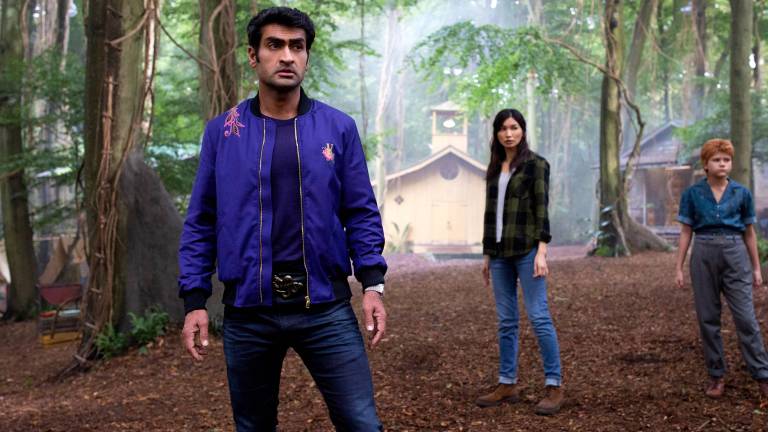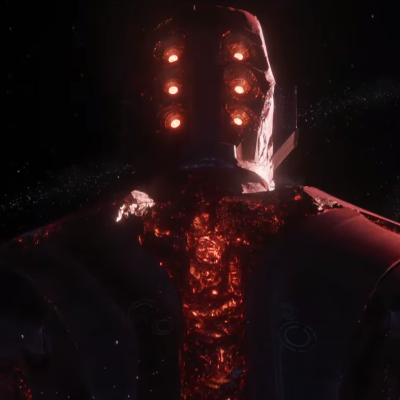Marvel Studios Should Make More Movies Like Eternals
This weekend’s Eternals arrives as the most divisive film Marvel Studios ever produced. They should be encouraged to make more movies like this.

This article contains Marvel’s Eternals spoilers.
I did not love Chloé Zhao’s Eternals. This isn’t a controversial statement to make for the first Marvel Studios film to receive a negative “Rotten” score on the aggregate movie review site, Rotten Tomatoes.
Despite its expansive pacing—which, believe it or not, is two minutes longer than Denis Villeneuve’s Dune—Eternals struggles to balance its competing impulses and obligations. The movie wants to be a superhero creation myth, but also a grandiose epic about the cyclical nature of violence; it attempts to be a melodrama about its dizzying cast of 10 broody protagonists, but it also must sell action figures with CGI beat ‘em ups. The film’s reach truly does exceed its grasp.
And yet, it still reached far outside the parameters of what we typically associate with a Marvel Studios movie. Often these guidelines and formulaic elements can be pointed to as a strong reason why Marvel has previously not struck out with most critics or moviegoers after 25 films. Some MCU movies are certainly better than others, but when safety rails are always up, you’re never going to throw a gutter ball. One of the many tradeoffs to playing it safe like this though is that the studio has rarely been able to allow a filmmaker to make the template their own. Or, to mix metaphors, there’s little chance of hitting a home run.
Some filmmakers like James Gunn, Taika Waititi, and Ryan Coogler certainly have pushed harder against these constraints, but there is no denying that when the entire climax of Black Panther is defanged by the poorly rendered CGI dolls who take over for Chadwick Boseman or Michael B. Jordan, that a dubious compromise has been made. Similarly, the compositions Taika Waititi had the time to lovingly craft in Jojo Rabbit are far more lively and playful than the often standard two or three-shot framings which comprise most character interactions in Thor: Ragnarok, a movie more amusingly written than the previous Thor movies but without even the visual flourishes of Kenneth Branagh’s first Thor flick from way back in 2011 (the last MCU movie to be shot on 35mm).
In other words, Black Panther, Thor: Ragnarok, and even the loopy Guardians of the Galaxy still looked like Marvel Studios movies and still felt like Marvel Studios movies.
Eternals does not, which is its greatest strength.
Marvel Is Seeing the (Natural) Light
Filmed before Chloé Zhao won a deserved Best Director Oscar for Nomadland, Eternals still benefits from Marvel Studios President Kevin Feige‘s confidence in the filmmaker behind The Rider. From its opening introduction of the team comprising the Eternals arriving on Earth some 7,000 years ago, the film’s earnestness is nearly startling. It takes a moment to sink in as Zhao’s setup absolutely refuses to indulge in the self-deprecating sarcasm which has become a defining feature of Marvel movies since 2012: She’s going to take this seriously, isn’t she?
For the most part, the answer is yes. Sometimes this creative choice works, and sometimes it doesn’t, but rarely does Eternals look like an ensemble of actors trading one-liners in front of a blue screen in Atlanta, Georgia. This perhaps explains comments Feige made a few months ago when he recalled extolling the visceral acuteness of Zhao’s eye to Disney executives.
“[Zhao] was really fighting for practical locations,” Feige told Variety. And when execs wondered about the cost of actually shooting in Spain’s Canary Islands or even (gasp) the real Piccadilly Circus in London (as opposed to using a green screen recreation of it), Feige said, “I had to keep saying, ‘This is right out of a camera; there’s no VFX work to this at all! Because it was a beautiful sunset, with perfect waves and mist coming up from the shore on the giant cliffside—really impressive stuff.”
At the time, social media and even some trades had fun tweaking Feige for supposedly not realizing you could actually film a sunset instead of building one in a computer. However, when you look at the visual aesthetic of most Marvel movies and compare it to Eternals, it’s easy to see why the Marvel boss would be so pleased.
Ever since the switch to digital photography in 2011, beginning with Captain America: The First Avenger, Marvel’s films have settled for a bland and often beige house style that accentuates the flatness of their colors. This kind of broad network television lighting made sense for a company eager to one day churn out four movies a year, one for each fiscal quarter. If the movies all look relatively the same, audiences are better conditioned to expect the same product every time they buy a ticket. The approach also complemented the ubiquitous digital effects. But with a few notable exceptions (primarily Gunn’s Guardians films), the hegemony of it all led to an increasingly stale and insulated visual palette.
For example, Black Panther is a film intended to celebrate an Afrofurist vision of Africa, and yet the only filming not done in front of green screens in Atlanta was when the filmmakers went to South Korea to shoot a chase scene. Otherwise, instead of seeking out real African waterfalls for the location where T’Challa claims his father’s throne, or a real savanna when he visits his father in his dreams, the film settled on building it all in a computer. Even so, it’s still certainly more visually interesting than the digital recreations of… an airport in Captain America: Civil War for that film’s centerpiece action sequence. Meanwhile this year’s highly anticipated Spider-Man: No Way Home seems to pivot around a fight scene occurring between New York City’s favorite superhero and the Sinister Six… on a nameless southeast highway.
While Zhao’s Eternals didn’t actually go to every location in the film, from the Australian Outback to the Amazonian Rainforest, its director was still able to film in the actual archipelagos, which offered both lushly green seaside landscapes and more arid alternatives.
She also filmed most of these sequences with her singular understanding of natural light. Never before has a Marvel Studios movie’s world looked so textured and tactile than on the islands where Eternals both begins and ends its story. And even when the film tries to pass an island off for a tropical climate, the emphasis on sunlight and torches makes Eternals’ natural and depopulated world feel more lived-in than the countless shiny and often vacant digital spaces other Marvel movies occupy.
A Real Civil War
But more than just visual tangibility, Zhao’s approach also brings a sincerity to the character components of the film. Character dynamics have of course been an element Marvel’s excelled at as a mass-producer of blockbuster entertainment. Competitors have attempted to mimic Marvel films’ ability to pivot between typical hero’s journey narrative beats and quippy banter—but the also-rans have never quite perfected that rhythm.
One might even argue Marvel itself has never captured it as organically as its originator, Joss Whedon, whose screenplay for The Avengers set the template. Still, the MCU has been able to finely tune the self-aware winks as a way to gloss over third acts that often rely on a numbing overabundance of meaningless MacGuffins and lifeless CGI spectacle.
However, unlike every other Marvel Studios movie released in the last five years not named Endgame, the third act of Eternals is its strongest section instead of its weakest. That’s because Zhao and company keep the film squarely rooted in the motivations of its main characters, especially Sersi (Gemma Chan), Ikaris (Richard Madden), and Sprite (Lia McHugh).
The relationships between these three characters and the rest of the surviving Eternals at-large is what makes the finale compelling instead of being a time-filler. There are also the usual “end of the world” stakes here, albeit embodied by the surreal image of a giant space-god (or “Celestial”) climbing out of the earth’s core instead of another generic sky-beam or falling sky fortress. Additionally, those stakes are simply a context for a passion play between our leads.
Ikaris, as it turns out, is the film’s villain. Despite looking like Marvel’s version of Superman (a fact the film blatantly calls out), the Eternals’ golden boy has lived for centuries with the knowledge that their mission to “help” humanity evolve was merely a prelude to a massive genocide where a Celestial is born and consumes all life on Earth. Knowledge of this horror drove Ikaris away from his lover Sersi for the last 500 years, and he’ll be damned if he must now change his mind at the last minute like his more empathetic leader, Ajak (Salma Hayek). So he kills Ajak and will even raise his hand against Sersi to ensure their primary duty is fulfilled.
Yet, most intriguingly, Eternals refuses to fully reduce Ikaris to “the bad guy” in usual superhero movie fashion for these actions. He’s a traitor among their ranks, but even if his mission is to destroy all life on Earth, the film at least plays devil’s advocate to see things from Ikaris’ point-of-view. And since it knows the audience is conditioned to not listen to anything he might say after it’s revealed he murdered Ajak, the film has that viewpoint espoused by… Kingo, Kumail Nanjiani’s lovable side character.
Up to that point, Kingo has been the sole comic relief in the whole film, but when faced with the choice of letting Earth die or preventing thousands of new stars and other worlds from ever existing thanks to another Celestial, Kingo sides with Ikaris.
Strangely, the film doesn’t even judge Kingo as wrong or weak for his decision. It rather accepts it as a differing viewpoint, allowing him to walk away from the story without punishment or rapprochement. Suddenly, the film pivots not on a fight between purely good and evil CGI creatures, but on a moral paradox that (faintly) asks viewers to consider destroying all life on Earth as somehow part of the greater good.
Granted, this is a superhero movie, so Eternals only lightly flirts with these elements and never bends toward nihilism. However, the film still attempts to create compelling conflict amongst its protagonists instead of a “heroes versus villains” cliché. No one is condemned. Kingo sides in all but action with Ikaris, and Sprite, who is enduring her own “Peter Pan” syndrome, actually takes a knife to her surrogate big sister Sersi. Neither are damned by the film for these actions. Genuine emotional stakes are raised by their betrayals, but the only reason Ikaris dies in the film is because of his own choice to not live with his sense of guilt.
This is an actual civil war where characters we like have ideological reasons to be torn asunder and do not make smirking jokes about it, as if to say “we all know we’re still friends after this is over.”
It’s a creative choice unlike anything Marvel’s previously made, including a film deceptively titled Captain America: Civil War. The boldness doesn’t necessarily save Eternals from its overlying problems, but it does allow the film to stand apart from anything Marvel made before.
Break the Marvel Conveyer Belt
Back when Captain America: The Winter Soldier was released in 2014, it came out in a sea of publicity about how the film wasn’t really a superhero movie. Feige described it as “a political thriller” the year before, and directors Joe and Anthony Russo compared it to 1970s thrillers like Three Days of the Condor and All the President’s Men. Well, despite the presence of Robert Redford, we doubt many were thinking of Watergate when it was revealed SHIELD wasn’t corrupted by self-proclaimed patriots doing what they thought was right, but by a secret HYDRA cult who was trying to take over the world via flying CG fortresses.
Similarly, Thor: The Dark World was sold as Marvel’s high-fantasy epic and in the same genre as Lord of the Rings and Game of Thrones (hence the hiring of frequent GoT director Alan Taylor). After folks saw the finished product, nobody bought that talking point.
So Thor 3 became, to quote star Mark Ruffalo, an “intergalactic buddy road movie.” During its best sequences, it really does feel like that as Ruffalo’s Hulk and Chris Hemsworth’s Thor pal around on Planet Jeff Goldblum. But that’s also only about one-third of the film, which otherwise spends most of its time also being about Thor fighting his sister Hela (Cate Blanchett) and setting up Avengers: Infinity War. By the end of Ragnarok, Hulk is little more than a CGI sidekick along for the ride.
By contrast, there’s little to no interconnectivity or larger MCU world-building in Eternals, nor much in the way of pandering to formula beyond the entirely perfunctory action sequences dealing with Deviants in the film’s first two acts (which are also by far the worst things in the movie). In the last year, Marvel has begun Phase 4 by taking more risks in the television realm, which paid off in their most experimental project to date, WandaVision, and fell flat with their most obligatory one, Falcon and the Winter Soldier. Nonetheless, there is a clear desire to break from formula at the House Iron Man Built.
Eternals is their first real attempt to do so in movie theaters. The result is uneven, overlong, and scattered. But a mixed critical response should not scare off Marvel from continuing to actually experiment in tone, aesthetic, and letting singular storytellers shoot on a real damn beach.


